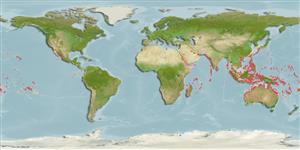Ophiuroidea |
Ophiacanthida |
Ophiocomidae
Environment: milieu / climate zone / depth range / distribution range
Ecology
Reef-associated; depth range 0 - 13 m (Ref. 81020). Tropical
Indo-Pacific: Red Sea to Hawaii and Japan.
Length at first maturity / Size / Weight / Age
Maturity: Lm ? range ? - ? cm Max length : 2.4 cm WD male/unsexed; (Ref. 87041)
Size refers to disc diameter (Ref. 87041). Occurs in small crevices or under stones on reef platform and in shallow (Ref. 800) rocky, and rock-sandy intertidal area (Ref. 130839). On inner reef flats, extending its arms from crevices and from under rubble (Ref. 97449). Feeds on detritus (Ref. 800) and neuston (Ref. 102356). May be a deposit feeder or suspension feeder (Ref. 102356).
Life cycle and mating behavior
Maturity | Reproduction | Spawning | Eggs | Fecundity | Larvae
Members of the class Ophiuroidea are mostly gonochoric, others are protandric. Fertilization is external. Brooding is common, bursae is used as brood chambers where the embryos develop into juveniles and later crawl out from the bursal slits. Life cycle: Embryos hatch into free-swimming planktotrophic larvae and later metamorphose into tiny brittle stars which sink down the bottom where they grow into adult form.
Schoppe, S. 2000 A guide to common shallow water sea stars, brittle stars, sea urchins, sea cucumbers and feather stars (echinoderms) of the Philippines. Times Media Private Limited, Singapore. 144 p. (Ref. 800)
IUCN Red List Status
(Ref. 130435: Version 2025-1)
CITES status (Ref. 108899)
Not Evaluated
Not Evaluated
Threat to humans
Harmless
Human uses
| FishSource |
Tools
More information
Population dynamicsGrowthMax. ages / sizesLength-weight rel.Length-length rel.Length-frequenciesMass conversionAbundance Life cycleReproductionMaturityFecunditySpawningEggsEgg developmentLarvae PhysiologyOxygen consumption
Human RelatedStamps, coins, misc.
Internet sources
Estimates based on models
Preferred temperature
(Ref.
115969): 24.6 - 29.3, mean 28.2 (based on 2846 cells).
Fishing Vulnerability
Low vulnerability (10 of 100).
Price category
Unknown.
